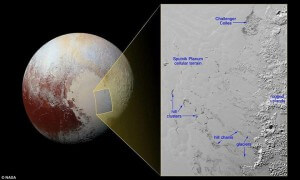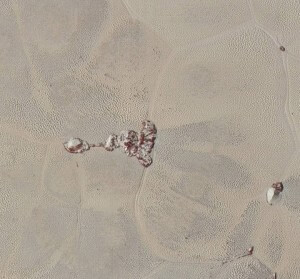 6
6




 29. 12. 2023
29. 12. 2023

NASA's New Horizons photographed the surface of Pluto with the Multispectral Visible Imaging Camera (MVIC) on July 14, 2015. Later, on December 24, 2015, the probe took images with the Long Range Reconnaissance Imager (LORRI) to obtain detailed photographs. huge heart-shaped ice plains, which was named Sputnik Planum - in honor of the first Soviet satellite. And in both cases, some strange objects were recorded. They seemed to be moving, leaving traces behind. They even called one of the objects a snail, due to its resemblance to an earth snail.
When you look at the picture carefully, you will see a dark object on a white background that casts a shadow on a light surface. Snail or snail? At the back we even see the legs and the front of the anvil. The trace left behind by the creature is obvious.
 Scientists immediately came to the conclusion that "snails" and other objects on the surface are lumps of water ice covered with dirt. But they lie on the surface. And recently, NASA clarified that the ice floes are made of water ice and these do not rise from the surface, but are sunk. They were sunk like ice floes on Earth, floating in the polar seas. On Pluto, the ice floes also drift, not only in the water, but in the frozen nitrogen.
Scientists immediately came to the conclusion that "snails" and other objects on the surface are lumps of water ice covered with dirt. But they lie on the surface. And recently, NASA clarified that the ice floes are made of water ice and these do not rise from the surface, but are sunk. They were sunk like ice floes on Earth, floating in the polar seas. On Pluto, the ice floes also drift, not only in the water, but in the frozen nitrogen.
The diameter of the glaciers in Pluto is several kilometers, but we can only see small ridges. The others are under the surface. Water ice is less dense than ice nitrogen.
At NASA, they believe that the ice floes on Pluto have split off from the local mountains. Some then merged into units reaching several tens of kilometers.
According to scientists, the plain itself is a reservoir of frozen nitrogen, which reaches a depth of several kilometers. Pluto is geologically active. Heat comes out of its core and heats the bottom. As a result, bubbles appear and rise to the surface after cooling. Then the mesh creates dimensions from 16 to 40 kilometers in diameter. They are visible in the photos. The edges of these meshes resemble snail tracks. And local glaciers can really move along these edges.
"Volcanic lava behaves similarly on Earth," explains William McKinnon, deputy head of the New Horizons Geology, Geophysics and Imaging team at Washington University, St. Louis.